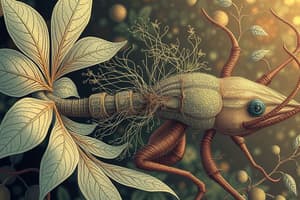Podcast
Questions and Answers
What is the primary function of the smooth endoplasmic reticulum (ER)?
What is the primary function of the smooth endoplasmic reticulum (ER)?
- Storage of calcium ions
- Modification of carbohydrates
- Synthesis of protein precursors
- Synthesis of lipids (correct)
In which direction does passive transport move substances?
In which direction does passive transport move substances?
- From low to high concentration
- From high to low concentration (correct)
- Against their concentration gradient
- In any direction depending on energy availability
What is the effect on a freshwater fish's cells when placed in seawater?
What is the effect on a freshwater fish's cells when placed in seawater?
- The cells lose water and shrink (correct)
- The cells burst due to excessive water intake
- The cells remain unchanged
- The cells swell due to water influx
How does a competitive inhibitor disrupt enzyme activity?
How does a competitive inhibitor disrupt enzyme activity?
What happens during non-competitive inhibition?
What happens during non-competitive inhibition?
What property of ice allows it to float on water?
What property of ice allows it to float on water?
Why is carbon considered a versatile element in organic compounds?
Why is carbon considered a versatile element in organic compounds?
Which of the following correctly describes a difference between DNA and RNA?
Which of the following correctly describes a difference between DNA and RNA?
What happens to a protein when it is denatured?
What happens to a protein when it is denatured?
Which of the following is NOT a characteristic of prokaryotic cells?
Which of the following is NOT a characteristic of prokaryotic cells?
What is the main function of lysosomes in a cell?
What is the main function of lysosomes in a cell?
How do phospholipids arrange themselves in an aqueous environment?
How do phospholipids arrange themselves in an aqueous environment?
What component of the endoplasmic reticulum (ER) does NOT differ between its two distinct regions?
What component of the endoplasmic reticulum (ER) does NOT differ between its two distinct regions?
Which of the following is NOT one of the seven properties of life?
Which of the following is NOT one of the seven properties of life?
What defines a theory in scientific terms?
What defines a theory in scientific terms?
Why is a control group essential in experiments?
Why is a control group essential in experiments?
Which of the following elements is NOT one of the four most common elements found in organisms?
Which of the following elements is NOT one of the four most common elements found in organisms?
What occurs when an atom changes its number of protons?
What occurs when an atom changes its number of protons?
What characterizes a covalent bond?
What characterizes a covalent bond?
Which of these organisms would most likely belong to the kingdom of Fungi?
Which of these organisms would most likely belong to the kingdom of Fungi?
What is the primary reason that ice floats in water?
What is the primary reason that ice floats in water?
Flashcards are hidden until you start studying
Study Notes
Properties of Life
- Life is characterized by seven properties:
- Ordered organization
- Regulation of internal environment (homeostasis)
- Growth and development
- Energy processing (metabolism)
- Response to the environment
- Reproduction
- Evolution (adaptation)
Organism Classification
- Organisms can be categorized into domains and kingdoms based on characteristics:
- An organism that produces food from sunlight is categorized under Plantae.
- Microscopic, nucleus-free organisms found in riverbeds belong to Bacteria.
- Organisms that decompose dead leaves are classified under Fungi.
- Organisms feeding on algae in ponds fit within Animalia.
Hypothesis vs. Theory
- A hypothesis is a testable prediction, while a theory is a well-supported explanation based on extensive evidence.
Control Groups in Experiments
- Experiments lacking control groups cannot provide clear conclusions since there’s no basis for comparison, making it difficult to identify the cause of observed changes.
Elements in Organisms
- An element is a pure substance that cannot be chemically decomposed.
- The four most common elements in living organisms are Carbon, Hydrogen, Oxygen, and Nitrogen.
Atoms, Ions, and Isotopes
- Atoms become ions by adding/removing electrons.
- Isotopes are variations of an element formed by changing the number of neutrons.
- Changing the number of protons transforms an atom into a different element.
Covalent Bonds
- Covalent bonds involve the sharing of electron pairs between atoms, contributing to stable electron configurations.
Properties of Ice
- Ice floats on water due to its lower density, resulting from a molecular structure that creates space as it freezes.
Carbon Versatility
- Carbon can form four covalent bonds, allowing for the creation of diverse organic compounds with complex structures.
Differences between DNA and RNA
- DNA is double-stranded, contains thymine, and has deoxyribose sugar.
- RNA is single-stranded, contains uracil, and uses ribose sugar.
Macromolecule Monomers
- Monosaccharides are the monomers of carbohydrates.
- Amino acids are the building blocks of proteins.
- Nucleotides make up nucleic acids.
- Triglycerides serve as the basic unit for lipids.
Protein Denaturation
- Proteins lose their functionality when denatured, as their specific 3-D shape is critical for operations and binding purposes.
Prokaryotic vs. Eukaryotic Cells
- Prokaryotic cells lack a nucleus and membrane-bound organelles, are typically smaller and simpler.
- Eukaryotic cells have a defined nucleus, contain membrane-bound organelles, and are larger and more complex.
Organelle Functions
- Ribosomes are essential for protein synthesis.
- Microtubules assist in movement.
- Mitochondria are responsible for cellular respiration.
- Chloroplasts conduct photosynthesis.
- Lysosomes manage digestion.
Phospholipid Bilayer
- In an aqueous environment, phospholipids form a bilayer with hydrophilic heads outward and hydrophobic tails inward, creating a protective cell membrane structure.
Endoplasmic Reticulum (ER)
- The rough ER synthesizes proteins, while the smooth ER is involved in lipid synthesis.
Energy and Entropy
- Energy is the ability to perform work, while entropy measures disorder or randomness within a system.
Transport Mechanisms
- Passive transport moves substances down their concentration gradient without energy; active transport moves substances against their gradient using energy.
Freshwater Fish in Hypertonic Solutions
- Exposure to hypertonic solutions results in freshwater fish cells losing water, shrinking due to osmosis, which aims to balance solute concentrations inside and outside the cells.
Enzyme Inhibition
- Competitive inhibitors block the active site, preventing substrate binding.
- Non-competitive inhibitors bind elsewhere, altering enzyme shape and reducing substrate binding efficiency.
Studying That Suits You
Use AI to generate personalized quizzes and flashcards to suit your learning preferences.




